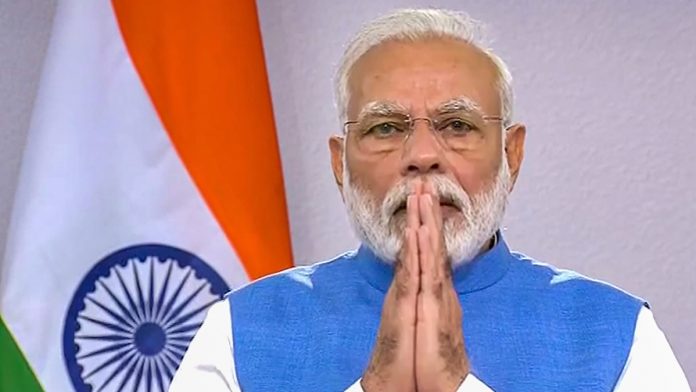Paradigm shifting reform rolled out with an omnibus relief package; implementation is key.
Appropriating catastrophe into probability, the Narendra Modi government has announced an omnibus package which seeks to transit the Covid-19 aftermath from survival to strength. In his true democratic style, the Prime Minister did not choose to hog the limelight while addressing the nation on the evening of 12 May. Rolling out the broad contours of the reform he was proposing, he dwelt at large on the need for “Atmanirbhar Bharat”—a self-reliant economy in which he gave the pivotal place to rural India and urged the people to be “vocal for local”.
Details of the bold, not incremental reforms have been enunciated by Finance Minister Nirmala Sitharaman and the Minister of State for Finance, Anurag Thakur, jointly, in the days that followed. Modus of the roll-out reflected team effort. Ministers of State had played important role in the governments of Jawaharlal Nehru, Indira Gandhi, Morarji Desai and Rajiv Gandhi. Somehow, in later years, the institution of the Minister of State was relegated into an “adjustment” position. During the Manmohan Singh regime, junior ministers used to openly complain that the Cabinet ministers rarely shared their burden with their Ministers of State. Since 2014, this perception was corrected and the announcement of the Atmanirbhar Bharat package has shown signs of not only economic reform but a changed paradigm in the running of the government as well.
Details of the package have been widely commented upon. Critics, especially the 280-letter Twitter warriors displayed their propensity for skepticism on the night of 12 May. As the week progressed, one-by-one their concerns and zapper fell by the wayside. Critics dwelt on the quantum, ignoring the quality of the package. Rahul Gandhi adherents, Mamata Banerjee, Akhilesh Yadav, Sitaram Yechury, et al, who prefer so see the negative side alone (and are entitled to their democratic right to differ) chastised. Mayawati differed but offered suggestions. Priyanka Vadra maintained her stance of critical appreciation—she has been highlighting through her regular tweets the plight of the migrant labourers and at the same time applauding positive steps, especially those undertaken in Uttar Pradesh. Senior Congress leader Anand Sharma cautiously welcomed the move. Congress Chief Minister of Rajasthan, Ashok Gehlot, under whose leadership the “Bhilwara model of containment”, now followed across the country, was developed, welcomed the package, saying, “Der aye, durust aye (better late than never)”.Yet another senior Congressman, former Maharashtra Chief Minister Prithviraj Chavan, while supporting the package, suggested that the government could appropriate all the gold lying with religious trusts across India, which according to the World Gold Council is estimated to be worth $1 trillion and boost the relief package. Chavan suggested this stock of yellow metal could be borrowed at a low interest rate as per the norms set by the Gold Monetisation Scheme introduced by the government of Atal Behari Vajpayee in 1999. The government’s move thus has received support and suggestions from across the political spectrum.
Narendra Modi’s various path breaking reforms unleashed since 2014, especially JAM—Jan Dhan-Aadhar-Mobile—have come in handy in tackling the Covid crisis. Direct Benefit Transfer to bank accounts coupled with the Bank Mitra concept (in rural areas, where agents deliver money to doorsteps) have proved useful. The robust public distribution system has come handy. India’s secondary and tertiary healthcare apparatus in rural areas, developed over the years, has provided necessary backup to the fight against Covid-19.
The Atmnirbhar Bharat campaign has seen the Chief of Defence Staff, Gen Bipin Rawat extol the armed forces to rely more on indigenous sources of supply. In the aftermath of the 1962 China war, India had developed a self-reliant defence production base. Jane’s Defence Weekly, the international benchmark publication, had noted the efficacy of Indian made small arms and artillery. India had a modest export initiative too—a cell under Major General Alfred in the Defense Ministry had ensured supplies to liberation movements in Africa and sold Indian hardware elsewhere. All this changed in the 1980s when imports became the order of the day. Gen Rawat has asked the armed forces to be less ambitious in setting their qualitative requirements. At present the GSQR—General Staff Qualitative Requirement—is often skewed in favour of foreign suppliers. Gen Rawat has pointed out that India does not need an expedition force, but has to be a defensive armed forces set-up, which can very well make do with the products of indigenous suppliers.
The key to the success of the survival-to-strength package will largely depend on its implementation. In this bureaucracy both at the Centre and in the states as well as state governments run by India’s medley of parties will play crucial role. Atmanirbhar Bharat package was preceded by BJP-ruled states rolling out incremental reforms, especially in the labour sector which are aimed at creating more investment and employment opportunities. If socialist Vietnam could reform labour laws to attract capital, so can India. The opposition to reform has been sounded by the BJP-affiliate trade union, Bharatiya Mazdoor Sangh, which has called for a protest on 20 May. Government’s intentions need a consensus within the political spectrum and a reform in the mindset of India’s bureaucracy.

